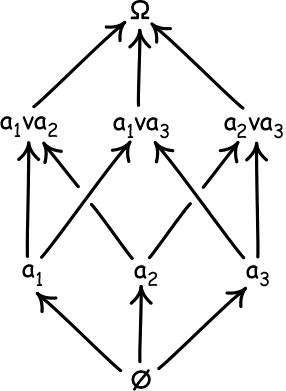
| 0 | 1 | 2 | 3 | 4 | 5 | 6 | 7 | 8 | 9 | What Logics of
Induction are There? John D. Norton |
A great deal of the analysis here depends upon the deductive definability in preferred partitions of the inductive strengths. As a result, many properties of the deductive structure are reflected within the inductive logic. One of the most important is this: whatever symmetries are present in the deductive structure must also be present in the inductive logic. So it is useful to develop a picture of just what the logical structure and these deductive symmetries look like. That proves to be quite easy with the help of pictures provided by directed graphs.
| Here's the simple case of a Boolean algebra with three atoms, a1, a2 and a3. The arrows represent deductive entailment. The graph depicts deductive inference emanating at the bottom from the contradiction that, in classical logic, deductively entails everything. It proceeds up through the atoms a1, a2 and a3, towards logically less specific propositions. These include the disjunctions of atoms, such as (a1 or a2), written as (a1 v a2). All deduction terminates in the universally true Ω. |  |
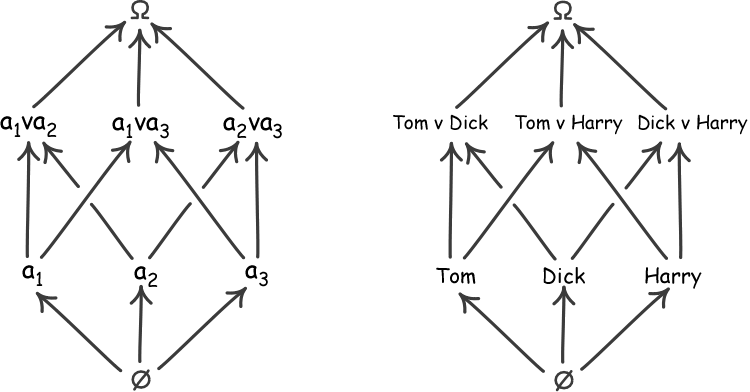 |
What matters for deductive structure is the way
these arrows connect the nodes of the graph. The
labels,a1, a2 and a3, attached to
the nodes have no intrinsic significance for the
deductive structure beyond their function of distinguishing
nodes. We could equally label them "Tom," "Dick" and "Harry" and still have the same three-atom deductive structure. |
| What this means, strictly speaking, is that labels
for the nodes are inessential. A good representation of the deductive
structure shows all the nodes as
intrinsically the same. We can get away with this in a picture in which the nodes look like identical spheres, for then the distinctness of the nodes is assured through the fact that they appear in a different part spatially in the figure. Aside from that distinctness, all properties of the nodes arise through their presence in the network of deductive entailments, that is, in so far as they play a role in the deductive structure. the contradiction is distinguished as the unique origin of all arrows of entailment. The universal Ω is distinguished as the unique endpoint of all inextensible chains of deductive inference. When we aren't using these graphical figures and our logic proceeds by writing formulae, however, we must use different symbols to distinguish the atoms. |
 |
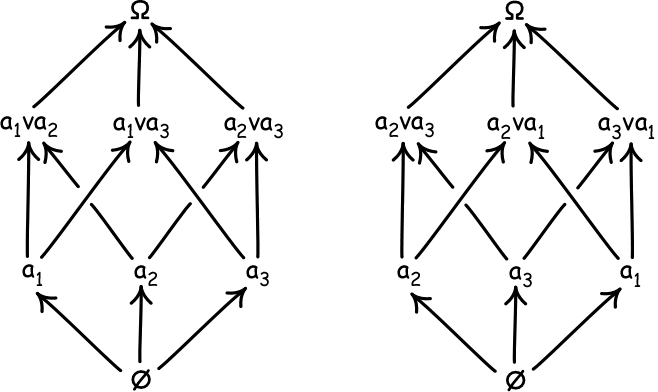 |
The symmetries of the deductive structure follow
immediately from this freedom to relabel the nodes while leaving the
deductive structure unchanged. This relabeling is called a symmetry transformation. It is a
transformation on aspects of the structure whose effect is to leave
the overall structure unchanged. One of the simplest of these transformations cyclically permutes the atoms: a1 to a2 a2 to a3 a3 to a1 |
| If we think of the graphs
representing the three-atom Boolean algebra as a figure in three
dimensional space, then the symmetries become
geometrical symmetries. The cyclic permutation just shown becomes a rotation about the vertical axis through 120o. |
A simpler permutation that just switches
a1 and a3 but leaves a2 unchanged is
a mirror reflection through a plane. |
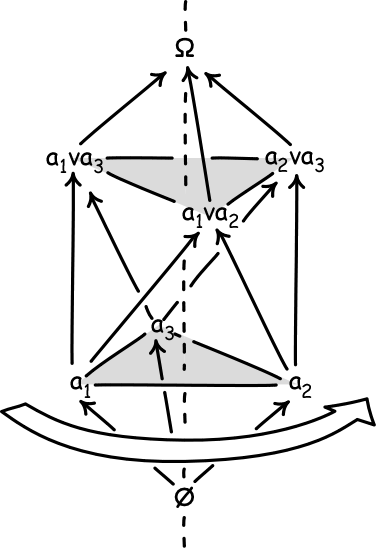 |
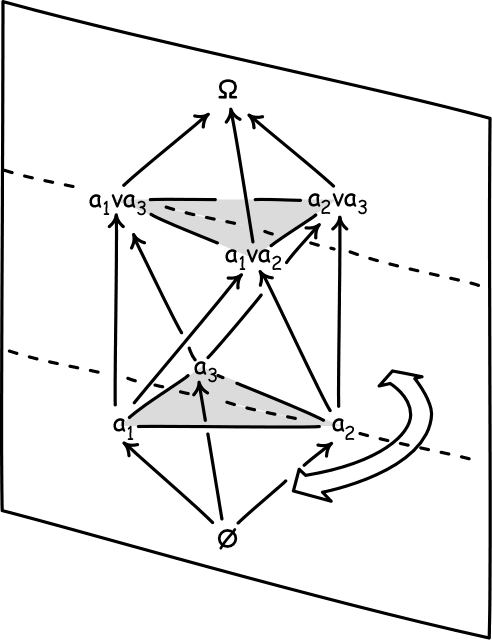 |
| Once we start looking for geometrical ways to
picture the symmetries, there is a simpler approach. We can also
encode the three-atom algebra
geometrically in a triangle. The corners are the three atoms
a1, a2 and a3. The sides are their
disjunctions. The symmetries of the algebra are once again
represented by the symmetries of the triangle. A cyclic permutation
of the three atoms is a rotation through 120o. This more compact representation gives us an easy figure for a four-atom algebra. It is just a tetrahedron, as shown at right. In general, an N-atom algebra is represented by an N-1 simplex, which is a higher dimensional analog of the triangle and tetrahedron. Unfortunately drawing one is no longer easy. |
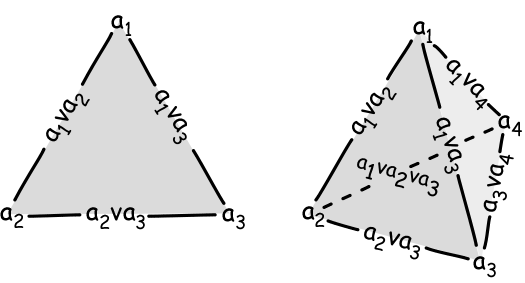 |
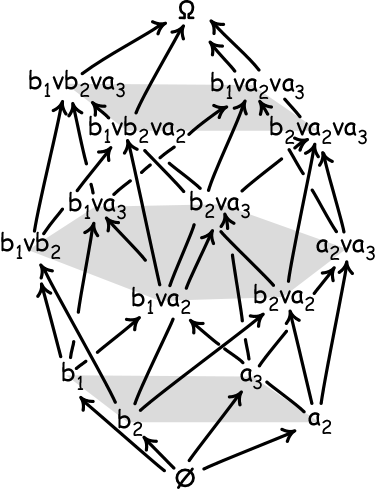 |
We can display graphs that show disjunctive
refinement. The graph as left shows the four-atom algebra that
results when we apply a disjunctive refinement to a three-atom
algebra. In this case, we have refined only by altering a1, which becomes b1 or b2. The other two atoms, a2 and a3 remain undivided. At first glance, this graph may appear bewildering. However, it does have a very orderly structure. It consists of three layers (aside from the contradiction and the universal proposition). The first layer contains the four atoms b1, b2, a2 and a3, which sit at the corners of a gray square. The second layer contains the six disjunctions of pairs of atoms,which sit at the corners of a gray hexagon. The third layer contains the four disjunctions of three atoms, which sit a the corners of a gray square. |
| This four-atom algebra begins to illustrate the deductive fact that is expressed in inductive logic as the generic presence of independence. The largest layer is the middle layer whose proposition are formed from 2 = 4/2 atoms. Since N=4, the effects that become pronounced for very large N are not yet visible. However as N grows much larger, this middle layer and those close to it come to contain virtually all propositions. This is illustrated more accurately in the picture at right, which shows a Boolean algebra for very large N. | 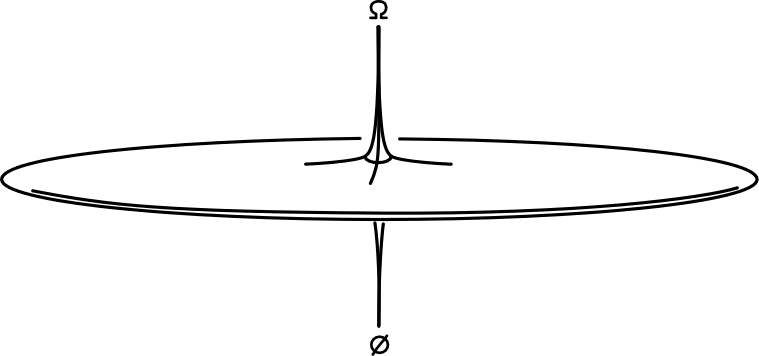 |
| 0 | 1 | 2 | 3 | 4 | 5 | 6 | 7 | 8 | 9 | What Logics of
Induction are There? John D. Norton |